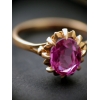|
 Alexandrite is the unique mineral among the other stones
which are highly appreciated. Subject to international pricing catalogue, faceted
pure 1-3 carat alexandrite from the Urals with the intensive effect of color
changing costs from two to twenty thousand dollars per carat, while the less
pure alexandrite from the same Urals will take you one to four thousands per
carat. A big size stone is rare and if it is worth paying fortunes for
something that is not a diamond? Alexandrite is the unique mineral among the other stones
which are highly appreciated. Subject to international pricing catalogue, faceted
pure 1-3 carat alexandrite from the Urals with the intensive effect of color
changing costs from two to twenty thousand dollars per carat, while the less
pure alexandrite from the same Urals will take you one to four thousands per
carat. A big size stone is rare and if it is worth paying fortunes for
something that is not a diamond?
The genuine connoisseurs are sure that alexandrite is worth
acquiring for this money, since pure stones occur far rarer than diamonds,
while the crystals refer to the precious stones of the first class. The rarity does
not allow the complicated treatment of the stone, though it is not necessary in
most cases. The alexandrite is magnificent enough to express the natural beauty
of facets by phased or drop-shaped diamond cutting which is more popular with
jewelers.
This rare gemstone was named after the Russian tsar
Alexander II (1818-1881), the very first crystals having been discovered in 1834
was thought to be the emerald (by the way, the alexandrite gems are found at emerald
mines), but when the «emerald» played with the blood red shades at the
artificial light, the miners revealed that this was the new and unusual crystal
which received the popularity in Russia. Though many sources state that the stone
was the first alexandrite ever mined, the gold alexandrite ring was found in
the burial place of the Polovtsian khan in Zaporozhe dated back XII century.
The miners believed that development of alexandrite at
emerald mines was the sign to stop mining good emeralds. And thanks to this belief
they missed alexandrite consciously.
However, the alexandrite won the fame among the Russian
royal family during the reign of Alexander II. The stone was believed to belong
to the royal elite and many people from the court tried to get a ring with
alexandrite and two diamonds. After the death of Alexander II the fashion for the
stone faded.
During post-war period the fashion for alexandrite tried to
revive. Though the gem was related to the huge number of «killed in battle
notices», therefore the crystal was called the «gem for widow». And since that
time the belief was spread that alexandrite is needed to wear in the couple to
avoid the evil. Though, this was related to the other mystery feature that the alexandrite
helped the stronger people making the weaker people unhappy who cannot cope
with situations. Persons of fortitude who survived the vital checks with the
alexandrite as a talisman are supported by the stone and they can expect the
fame, wealth and success in all their doings.
Nowadays alexandrite is highly appreciated in spite of the
prejudice related to this stone. Thanks to unusual features to change the
shade, alexandrite may become the worthy decoration for any jewel. Yet, the
natural crystal should not be confused with the fake, when the skillfully done
fake crystals can change the color insignificantly or are two-color
preliminary, though they have not genuine features and beauty of natural
alexandrite.
Synthetic corundums prickled with trace elements that defer
an alexandrite-like color change are sold as alexandrite, while alexandrite is
a crystal for experts, enthusiasts and connoisseurs. Its exclusivity and high
value are not evident at first sight. But if you really get involved in
alexandrite, you will be utterly fascinated by this gem. Maybe you will also
feel some of the mysterious magic and wisdom ascribed to it. It is considered a
stone of very good omen. In critical situations it is supposed to strengthen
the wearer’s intuition, and thus help him or her find new ways forward in
situations where sense will not provide an answer. Alexandrite is also reputed
to support inspiration and encourage the imagination.
The deposits of alexandrite stones also matter since the
color and cost are related to the place. The most vivid and contrasting stones are
mined in the Urals when crystals of blue to green shade become blood red at the
artificial light. Ceylon alexandrite come with the rich olive-green color which
goes into the orange-red at the light.
Also the stones from Sri-Lanka, Brazil, USA, Zambia,
Tanzania and Madagascar are highly demanded, though the Ural precious stones
are number one crystals in beauty and contrasting shades.
|